
Kids and Carbs: Finding the best fuel for our children
For many people, carbohydrate (carb) has almost become a dirty word – something to be avoided at all costs. While some adults may feel healthy following lower-carb diets, it’s important to realise that carbohydrates are a vital fuel for our children. All carbs are not created equal, however. Some are great, healthy choices, and others are the opposite, but it can be difficult to know the best choices to put on our children’s plates. In this Mother Duck newsletter (and continuing next month) I’m going to demystify them by explaining where we find different sorts of carbohydrates. This will make it easier to identify those that will power your children through their day and those they’d be better off without.
What are carbohydrates and where do we find them?
Carbohydrates are the body’s main fuel source like petrol is the fuel for our cars. They include all the sugars and starches we eat. Thus, carbohydrates are found in a huge range of foods, from sugary fizzy drinks to starchy wholegrain bread. The difference lies in how they are absorbed into the body. Sugars are small molecules, like small particles – they’re also called ‘simple carbohydrates’. Because they’re small they are able to pass from our stomach and intestine into our blood quite easily, which means sugar can move into the bloodstream relatively quickly after we eat it. The body then releases insulin, a hormone that takes the sugar out of the blood and into body tissues such as muscles and the brain, where it is used for fuel.
Starches are made of sugar molecules joined together in long strings – they’re also called ‘complex carbohydrates’. They’re too big for the body to absorb them as they are – the digestive juices first have to break the starch down into smaller chunks of sugar molecules. This takes time, so the sugar from starches generally enters the bloodstream more slowly, and a lower insulin level is required to move it into muscles and other parts of the body. It means that the starchy foods will usually provide fuel for the body over a longer period of time than the sugary foods.
This is just one of the reasons starches are a superior form of fuel to sugars. There’s also the fact that starches are often found in more nutritious foods that bring along other nutrients such as vitamins and minerals and fibre – think brown rice versus a chocolate biscuit.
There are a few exceptions – while sugary foods like chocolate and cordials are not good for us, sugars are also found in fruits, some vegetables and dairy foods. These foods are an important part of a healthy diet. Luckily the fibre that helps to make the fruit and veg so healthy for us also slows the absorption of sugar. Dairy foods also come as a nutrition package that promotes slower sugar absorption.
Choosing better carbs
It’s natural for kids to have a sweet tooth – babies are born with a preference for sweet flavours. However, we parents and carers do have a responsibility to teach children that sweet foods need to be limited. There are several reasons for this, including the extra calories that can be consumed very quickly in, for example, a can of lemonade. There’s also the fact that too many sweet foods can fill kids up so they lose their appetite for the more nutritious foods they need to eat. Here are a few tips to help kids cut down on the carbs their bodies don’t need.
Don’t drink sugar
Many common drinks, such as fizzy drinks, juices, squashes, sports drinks, and flavoured milks, contain added sugar. This can quickly add up to a lot of extra sugar. The best drinks for children are water and plain milk – they do not need any other drinks, so sweet drinks can be seen as a treat food to be enjoyed occasionally (and well diluted for younger children).
What about fruit juice?
While we all know fruit is a healthy food for our children, what about fruit juice? It is a great source of the same vitamins and other nutrients we find in fruit, apart from the fibre. And that’s a crucial difference. We would all struggle to eat three whole oranges because the fibre would fill us up, but it’s very easy to drink the juice of three oranges and maybe get more kilojoules than our bodies need. The dietary guidelines recommend limiting fruit juice to small amounts, consumed occasionally, and not given to children under the age of 12 months. I agree with that, though it can sometimes be a way for children to get the nutrients from fruit if they’re going through a phase where they absolutely won’t eat any fruit. In most cases though, I’d recommend keeping juice to a ‘treat’ drink for special occasions and definitely not every day. I’d add to that the suggestion to water down fruit juice for young children, whose taste buds are much more sensitive than our adult ones and don’t need so much sugar to enjoy a sweet drink.

Spotting the sweet food
Sugar is lurking in many foods. I don’t think there’s cause for concern with small amounts that are eaten as part of a meal, a little jam on wholegrain toast, for example. But other foods such as sweetened breakfast cereals can contain quite a lot, so it pays to look at the labels and compare different brands. Some foods to watch out for include chocolate and other lollies, sweetened yogurts and puddings, fruits tinned in syrup, and cakes and biscuits.
Note that sugar in ingredient lists may be called by different names including sucrose, fructose, glucose, corn syrup, and honey. Whatever the label says, if the food is sweet, it must contain some form of sugar or artificial sweetener and might be a food to watch out for.
Fuelling your child’s day
Just as a car won’t go far without the right fuel, our kids (and grownups as well) will never be at our best without the right foods. The right carbs at the right times will help to maintain children’s energy levels for play, and their concentration for learning, and it may bring a side benefit of keeping their moods more even. This means aiming for:
Regular meals
If we feed our children three meals a day, it will help their bodies to stay fuelled for fun, activity, and learning throughout the day. Try to include some carbohydrates, particularly the starchy foods, at each meal. In particular, try to include some at breakfast – many studies have shown that children who go to school without breakfast do not learn as well, and it’s sure to have negative effects for younger kids too (and their parents!).
Great choices to fuel your children include:
- Breads and similar foods, including naan, pitta, English muffin and crumpets
- Breakfast cereals (look for lower sugar choices)
- Pasta and rice
- Other grain foods such as barley, cous cous and quinoa
- Fruit and starchy vegetables such as potato and sweet potato
- Dairy foods such as milk and yogurt (look for lower-sugar options or add plain yogurt to chopped or pureed fruit

Nutritious snacks
While too many snacks can ruin children’s appetite for their main meals, their bodies do need refuelling more often than adults. Thus, snacks are often essential, especially when it’s a long time between meals. There’s nothing wrong with snacking, so long as the foods are nutritious. Choosing healthy-carb options will help to give kids the get-up-and-go to keep them powering on until their next meal.
Occasional sugary treats
It’s unrealistic to expect children to eat a perfect diet, and everyone enjoys an occasional treat. However, it’s vital that our little ones learn that sugary foods are not a regular part of their diet and not an everyday food. It’s also useful to keep treats child-sized, and cut down adult-sized chocolate bars, slices of cake, and other sweet foods into child-friendly portions.
A note about fibre
Very young children don’t need a lot of fibre – too much can fill them up so much that they may not be able to fit in all the food they need. However, as they grow older the amount of fibre-rich foods can increase, so that by their fifth birthday, most starchy foods should be wholegrain, as all the family should be eating.
What about GI?
I’ll go a bit further in the next newsletter with the facts on low-GI foods and how they can help sustain our children for longer. In the meantime, enjoy a great month with your carb-fuelled kids.
© Fiona Hinton 2023
MEDICAL DISCLAIMER: Please note that this blog is for general information only, and should not be taken as a substitute for qualified medical advice. Please discuss medical issues with your child’s doctor before taking any action.
About Fiona: Fiona Hinton is a dietitian, but describes herself as a nutrition translator, taking the science of nutrition and translating it into foods we love to eat, to nourish both body and soul. She has over 20 years of experience as a dietitian, working in a wide range of areas from hospital wards to running her own private practice. Fiona has a special interest in children’s nutrition. As a mum of three school-age boys, she has first-hand experience of the issues associated with feeding young children, such as weaning and fussiness. Fiona specialises in real-life strategies and practical suggestions to convert nutrition advice into food kids will eat. Fiona has collaborated on several books, including one with best-selling children’s food writer Annabel Karmel, as well as training childcare staff in children’s nutrition.



